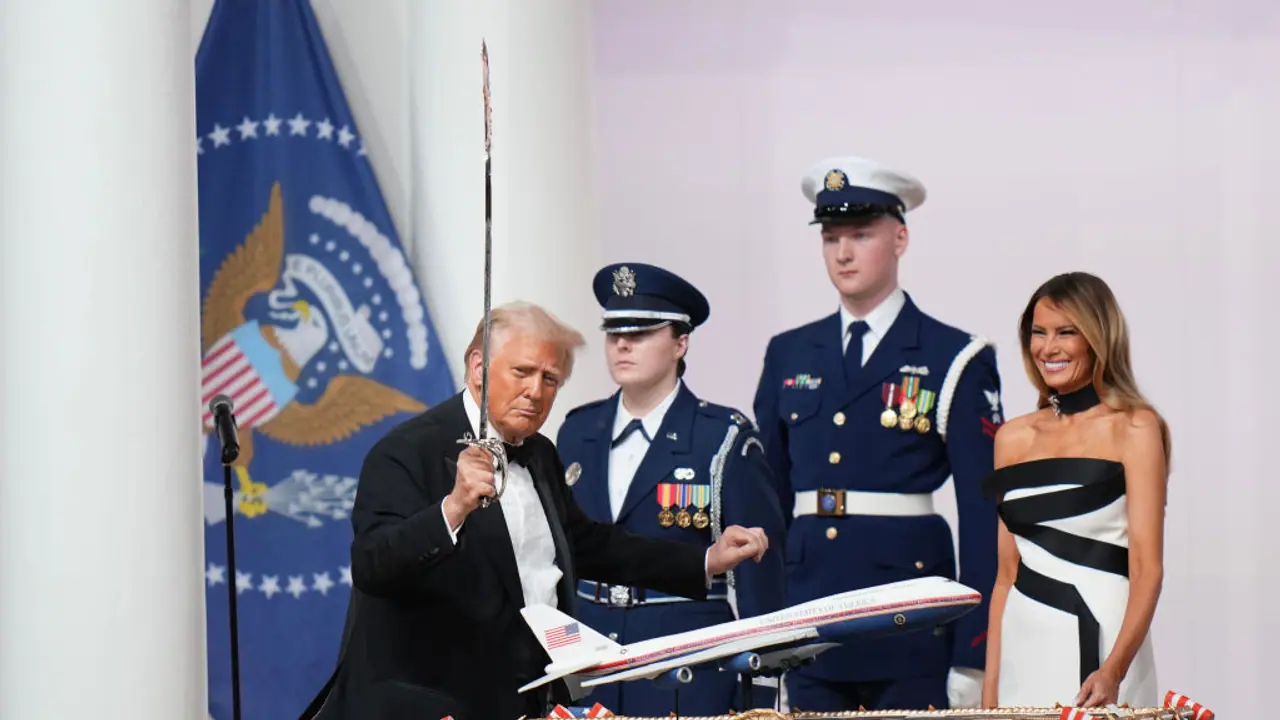US President Donald Trump and First Lady Melania Trump also shared their first dance of the night, adhering to the longstanding inauguration tradition.
US President Donald Trump made a striking appearance at the Commander-in-Chief Ball on Monday night, one of three inauguration day events he attended. The highlight of the evening was Trump wielding a ceremonial saber, which he used to cut a military-themed cake, followed by breaking into his signature YMCA dance moves.

The president and First Lady Melania Trump also shared their first dance of the night, adhering to the longstanding inauguration tradition. The couple swayed to the tune of the Battle Hymn of the Republic, joined on the dance floor by JD and Usha Vance, adding a personal touch to the celebratory evening.
WATCH: US President Donald Trump cuts cake and dances with sword at inaugural ball
Trump, addressing the crowd during the ball, expressed his gratitude for serving as president for a second term and reiterated his commitment to strengthening the US military. He gave a special mention to the Space Force, a military branch established during his first term.
"We are going to make the military so strong that we don’t have to use it," Trump declared, drawing cheers from the audience. Ending his speech with a patriotic note, he said, "God bless you, God bless our armed forces, and God bless the United States of America." The room erupted in chants of "USA, USA."
Trump emphasized that a significant reason behind his electoral victory was his rapport with the military. Praising Pete Hegseth, his choice for the next Secretary of Defense, Trump promised to rebuild the armed forces to be "the most powerful military the world has ever seen." He also hinted at plans for a new "iron dome," vowing that the country would focus solely on "defeating America's enemies."
Trump Signs Series of Controversial Executive Orders on First Day in Office
On his first day back in office, President Donald Trump signed a series of sweeping executive orders aimed at fulfilling his campaign promises, including pardoning January 6 defendants, rolling back immigration policies, and undoing actions implemented by Joe Biden’s administration. Trump signed several orders in front of supporters at the Capital One Arena in Washington, D.C., followed by additional signings during a press conference in the Oval Office.
Here are the key actions taken:
Mass Pardons for January 6 Defendants: Trump pardoned approximately 1,500 individuals facing prosecution for their involvement in the 2021 Capitol attack. Among those pardoned were Enrique Tarrio, the former leader of the Proud Boys, who was serving a 22-year sentence for seditious conspiracy, and Stewart Rhodes, founder of the Oath Keepers militia, whose 18-year sentence for sedition was commuted.
Redefinition of Gender in Federal Policy: An executive order now mandates federal agencies to revoke the use of terms such as "gender" and "gender identity," instead adopting a binary definition of “sex” in policy implementation, including on passports. LGBTQ+ rights organizations have announced plans to challenge this order in court.
Attempt to Revoke Birthright Citizenship: Trump signed an order to end birthright citizenship for children of undocumented immigrants born in the U.S. Despite the 14th Amendment’s protection of birthright citizenship, Trump has pushed forward, setting the stage for legal battles.
Undoing Biden’s Actions: Trump rescinded 78 executive actions issued by Joe Biden during his presidency.
Exit from International Agreements: Trump reissued orders to withdraw the U.S. from the Paris Climate Agreement and the World Health Organization (WHO). Regarding the WHO, Trump remarked, “World Health ripped us off, everybody rips off the United States. It’s not going to happen anymore.” The move would significantly impact funding for the global public health body.
Renaming Geographic Landmarks: Trump signed orders to rename the Gulf of Mexico as the "Gulf of America" and to revert the name of Alaska's Denali, North America’s highest peak, back to Mount McKinley, its name prior to Barack Obama’s 2015 renaming. These changes are largely symbolic and will not affect international usage.
